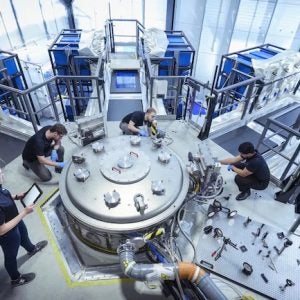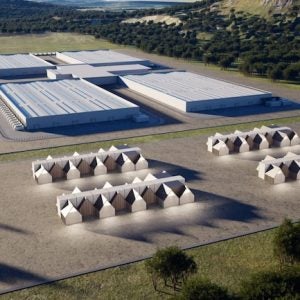 Specialists at Russia’s Kurchatov Institute, working on the development of a fusion-fission hybrid power plant, have completed its preliminary design.
Specialists at Russia’s Kurchatov Institute, working on the development of a fusion-fission hybrid power plant, have completed its preliminary design.
During work on the project, the specialists solved a number of problems – from substantiating the physical principles of the installation to ensuring the safety of its operation.
The results of this work were published in the journals Nuclear Fusion, Fusion Science and Technology, and Fusion Engineering and Design.
Hybrid systems are based on the combined use of thermonuclear fusion and nuclear fission reactions. Thermonuclear fusion is used not directly for generating electricity but as a neutron source that controls the subcritical core of a nuclear reactor. With the help of hybrid technologies, it is possible to efficiently process long-lived nuclear waste from nuclear power plants – minor actinides, as well as obtain new types of fuel for fission reactors.
"The exhaustion of fossil natural resources and environmental problems necessitate the creation of new sources of energy supply. In this regard, hybrid technology is one of the promising strategies, since it makes it possible to close the nuclear fuel cycle and improve its environmental performance," explained Boris Kuteev, deputy head of the tokamak department for hybrid systems at the Kurchatov complex of thermonuclear energy and plasma technologies.
With the help of such technology, long-lived waste from nuclear power plants can be effectively recycled. For example, one industrial hybrid plant with a capacity of 1GWe is sufficient to process all the high-level nuclides accumulated in Russia, to provide fuel for two thermal-neutron power plants or to launch a fast-neutron power plant, he said.
During the work on the "hybrid" project, scientists have substantiated the physical principles of the installation, writing program codes, working out individual architecture elements to integrating them into a single system and have solved security issues.
Significant progress has been made in the optimisation of structural and functional materials for thermonuclear reactors and hybrid systems. In addition, approaches were proposed for additional heating of plasma with neutron beams and a fuel cycle architecture was developed.
"Feeding the plasma with thermonuclear fuel – heavy isotopes of hydrogen (deuterium and tritium), removing the products of a thermonuclear reaction (helium) and, most importantly, the possibility of multiple use of the fuel mixture in the fuel cycle provides conditions for the continuous operation of a thermonuclear reactor and a hybrid system", explained leading researcher Sergei Ananiev.
He said, the DEMO-TIN thermonuclear neutron source will become the first hybrid installation for demonstrating basic technologies and their integration into a single energy complex.
At this stage, the researchers have formed the requirements for experimental equipment and are ready to start creating a prototype for testing a promising hybrid technology at a thermal power level of up to 500MW. The work has also involved specialists from the DV Efremov Scientific Research Institute of Electrophysical Apparatus (NIIEFA), the NN Dollezhal Research & Development Institute of Power Engineering (NIKIET) and the Peter the Great St Petersburg Polytechnic University (SPbPU).
Earlier it was reported that Rosatom had developed a superconducting wire for the DEMO-TIN hybrid reactor. Scientists at the AA Bochvar Research Institute of Inorganic Materials (VNIINM), on the instructions of fuel company TVEL, completed the development of the design and manufacturing technology of superconducting wires for the DEMO-TIN magnetic system.
Experimental batches of niobium-tin strand with a diameter of 1.0mm were made and successfully passed acceptance tests for compliance with the technical requirements of NIIEFA, the developer of the magnetic system. The acceptance committee, comprised specialists from TVEL, the Kurchatov Institute, NIIEFA, VNIINM and the Chepetsky Mechanical Plant (ChMZ).
In the central solenoid and toroidal coils of the magnetic system of these plants, superconducting strands with a current carrying capacity of more than 1100 amperes per square millimeter in a field with 12 tesla magnetic induction are needed. This is significantly higher than the characteristics of the strands previously developed by VNIINM for use in the ITER (International Thermonuclear Research Reactor) tokamak magnetic system.
A distinctive design feature of the new wire is the use of a common barrier that separates a group of multi-fibre elements from an external copper stabilizing sheath. In turn, each multi-fibre sub-element consists of many niobium fibres located in a copper matrix, as well as a tin source. To increase the current carrying capacity of the niobium-tin strand, each fibre is doped with titanium.
“This development by VNIINM is a serious step towards creating a wire for use in magnetic systems of controlled thermonuclear fusion plants of the DEMO-TIN type. A technology has been created and tested that allows the production of such products in the required quantity. A further step could be developments aimed at optimising the characteristics of the strands for specific projects,” noted NIIEFA Deputy General Director Igor Rodin.






